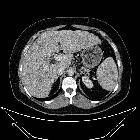Sarcoidosis (abdominal manifestations)


















Sarcoidosis is a systemic inflammatory disease of unknown origin characterized by the formation of non-caseating granulomas. Virtually any organ system may be involved. Although less common than pulmonary and mediastinal disease, abdominal sarcoidosis can mimic more common infectious or neoplastic conditions (especially lymphoma) resulting in unnecessary morbidity.
This article focuses on abdominal manifestations of sarcoidosis. For a general discussion of the condition please refer to sarcoidosis.
Epidemiology
- ages 20-50 are most common
- slightly more common in women than men
- presentation may vary widely with geography and ethnicity
Organs involved:
- liver and spleen are the most frequently involved viscera, with granulomata noted in 40-70% of patients
- renal involvement is seen in 8-19% of patients
- pancreatic, intestinal, and testicular sarcoidosis have been found in 5% or less of patients at autopsy
Clinical presentation
Abdominal viscera are frequently involved in sarcoidosis, although this involvement usually does not produce symptoms. Symptomatic liver disease occurs in less than 5% of patients with sarcoidosis. Laboratory evidence of liver dysfunction is seen in 2-60% of patients, with the alkaline phosphatase level being most commonly affected .
Pathology
Although the etiology of sarcoidosis is unknown, speculation has centered on the interaction of an unknown antigenic factor triggering an exaggerated cellular immune response in genetically susceptible individuals .
Histologically, the diameter of granulomatous lesions in the liver is generally <2 mm. The appearance of the larger lesions is probably caused by a coalescence of small granulomas.
Some patients with marked hepatosplenomegaly have no lesions, on the other hand, nodular lesions can be seen in patients who have only slight enlargement of the liver and spleen .
There is no correlation between nodular hepatosplenic sarcoidosis and advanced pulmonary sarcoidosis .
Radiographic features
Imaging findings usually consist of either homogeneous organomegaly or nodular infiltration.
Liver and spleen
- usually, some enlargement of the liver (hepatomegaly) and spleen (splenomegaly) is seen and can be depicted with ultrasound, CT and MRI
- ultrasound:
- pattern of either diffuse increased homogeneous or heterogeneous echogenicity
- nodules are usually hypoechoic relative to the background liver
- CT and MRI:
- in most patients the liver is homogeneous
- ~10-15% of patients show hypoattenuating/hypointense liver and/or spleen nodules ranging in size from 5-20 mm that correspond with coalescing granulomas
- the nodules become more confluent with increasing size
- on contrast-enhanced CT liver nodules appear as hypoattenuating masses relative to adjacent normal parenchyma
- on MRI the lesions are hypointense on all sequences and hypoenhancing relative to the background parenchyma
Biliary tree
- sarcoid can involve the intra or extrahepatic biliary tree
- intrahepatic involvement is granulomatous and produces cholestatic and primary biliary cirrhosis like picture
- extrahepatic involvement results in stricture and cholestasis, which appears like cholangiocarcinoma.
- enlarged portal nodes may produce cholestasis
Pancreas
- sarcoid involvement of the pancreas is uncommon.
- the imaging manifestations of pancreatitis resulting from sarcoidosis are indistinguishable from those of pancreatitis caused by other conditions
Gastrointestinal tract
- involvement of the gastrointestinal tract is rare and when present it is usually associated with pulmonary disease
- the stomach is the most common site of involvement and the radiological signs of the disease are very non-specific, ranging from mucosal thickening (mimicking Menetrier disease) to lesions mimicking gastric ulcers or linitis plastica
Genitourinary tract
- renal involvement is seen in 7-22% of patients
- in male patients the epididymis and the testis can be involved
- CECT scan may show signs of interstitial nephritis or less frequently multiple hypoattenuating nodules that resemble lymphoma or metastases
- when the epididymis is involved, MRI shows heterogeneous and nodular enlargement with a slight increase in signal intensity on the T2-weighted images
- sonographically, the resultant masses are homogeneously hypoechoic
- hydronephrosis may be caused by compression of the ureters by enlarged retroperitoneal nodes
Lymph nodes
- enlarged lymph nodes are usually found in the following areas :
- porta hepatis
- para-aortic region
- celiac axis
- superior mesenteric artery
- gastrohepatic ligament
- retrocrural region
- up to 30% of patients have moderate abdominal adenopathy (2 or more nodes with a short axis >1 cm or nodes in the retrocrural area with a short axis >6 mm) .
- around 10% of patients have extensive adenopathy (>2 cm and involvement of more than 4 sites)
- lymphadenopathy can be demonstrated with ultrasound, CT and MRI
Abdominal wall
- sarcoidosis can involve the muscles and produce either a nodular, myopathic or myositic appearance
- radiographic changes include nodules extending along the muscle fibers
- the atrophic myopathic form is characterized by muscular atrophy and fatty infiltration
Differential diagnosis
Imaging differential considerations include
- metastases:
- simultaneous involvement of liver and spleen makes metastatic disease less likely and favors the diagnosis of sarcoidosis and lymphoma
- lymphoma:
- lymph node enlargement is more pronounced
- conglomeration of lymph nodes is more frequent in lymphoma
- retrocrural lymph nodes are more frequently involved
- infectious disease:
- liver lesions may simulate disseminated hepatic microabscesses such as those seen in Candida, Staphylococcus and Aspergillus infections
Siehe auch:
- Sarkoidose der Milz
- Sarkoidose
- Sarkoidose der Leber
- Neurosarkoidose
- pulmonale und mediastinale Sarcoidose
- Metastasenleber
- Tuberkulose der Leber
- Lebergranulom
- kardiale Beteiligung bei Sarkoidose
- granulomatöse Lebererkrankungen
und weiter:

 Assoziationen und Differentialdiagnosen zu abdominelle Manifestationen der Sarkoidose:
Assoziationen und Differentialdiagnosen zu abdominelle Manifestationen der Sarkoidose:







